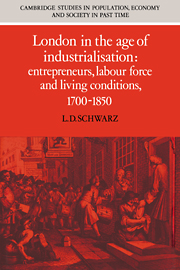Book contents
- Frontmatter
- Contents
- List of figures
- List of tables
- Acknowledgements
- List of abbreviations
- Introduction
- Part I Wealth and occupations in London
- Part II Fluctuations and mortality in the metropolis
- Part III The standard of living and the London trades
- 6 The making of a wage rate
- 7 The challenge of sweated labour: a tale of four trades
- 8 The defences of the inferior artisans
- Conclusion: downstream from industrialisation
- Appendices
- Bibliography
- Index
- Cambridge Studies in Population, Economy and Society in Past Time
7 - The challenge of sweated labour: a tale of four trades
Published online by Cambridge University Press: 11 September 2009
- Frontmatter
- Contents
- List of figures
- List of tables
- Acknowledgements
- List of abbreviations
- Introduction
- Part I Wealth and occupations in London
- Part II Fluctuations and mortality in the metropolis
- Part III The standard of living and the London trades
- 6 The making of a wage rate
- 7 The challenge of sweated labour: a tale of four trades
- 8 The defences of the inferior artisans
- Conclusion: downstream from industrialisation
- Appendices
- Bibliography
- Index
- Cambridge Studies in Population, Economy and Society in Past Time
Summary
On the existence of sweated labour before Henry Mayhew
When Mayhew was doing his rounds for the Morning Chronicle during the year before the Great Exhibition, the sweated domestic workers whom he interviewed knew precisely when their plight had begun.
Of the 21,000 working tailors … resident in London, I should add that there are not above 3,000 belonging to what is called the honourable portion of the trade. The remaining 18,000 are those who are engaged in the cheap, slop, or dishonourable trade …
Up to the year 1834, the 8th of George III (‘which,’ I am told, ‘regulated the time of labour for tailors at twelve hours per day, with the intent of compelling the masters to get their work done on the premises, as well as of equalising employment, and giving to each operative tailor the opportunity of earning a decent maintenance for himself and his family’) was tolerably well adhered to; but at that period the masters gradually infringed the provisions of the act. Sweaters became numerous, and a general strike was the consequence. The strike acted antagonistically to the view of the journeymen tailors, and from that time up to the present, sweaters and underpaid workmen have increased, until the state of trade, as regards the operative tailors, appears to be approaching desperation.
- Type
- Chapter
- Information
- London in the Age of IndustrialisationEntrepreneurs, Labour Force and Living Conditions, 1700–1850, pp. 179 - 208Publisher: Cambridge University PressPrint publication year: 1992



